2. 中国科学院精密测量科学与技术创新研究院大地测量与地球动力学国家重点实验室, 武汉 430077;
3. 北京卫星环境工程研究所, 可靠性与环境工程技术重点实验室, 北京 100094;
4. 吉林省地震局, 长春 130117
2. State Key Laboratory of Geodesy and Earth's Dynamics, Wuhan Institute of Physics and Mathematics, Chinese Academy of Sciences, Wuhan 430077, China;
3. Beijing Institute of Spacecraft Environment Engineering, Beijing 100094, China;
4. Jilin Earthquake Agency, China Earthquake Administration, Changchun 130117, China
沉积盆地地区一般蕴藏有大量的油气资源.近年来,随着油气资源的开发,盆地中地震活动性逐渐增加,并发生了一系列中等强度地震.例如,美国Oklahoma地区2011年11月分别发生了多次MW5.0+地震. 震中烈度8级左右,导致14座房屋摧毁,并造成数人受伤带来巨大的经济损失(U.S. Geological Survey, 2011).在2016年间,Oklahoma州发生了3个5级以上的地震,分别是MW5.1 Fairview地震(Yeck et al., 2016; Goebel et al., 2017)、MW5.8 Pawnee地震(Chen et al., 2017)和MW5.0 Cushin地震.同时,在中国四川盆地以及松原盆地地区,中等强度地震的活动性也有所增加.例如,在2019年在四川盆地南缘的宜宾市发生了多次5级以上地震,造成了重大人员伤亡以及社会经济损失(Lei et al., 2019; 易桂喜等, 2019).极浅震源深度是这些盆地中的地震成灾严重的主要原因之一.
震源深度通常可以通过震相到时以及地震波形数据来获取.其中,地震质心深度可以通过波形拟合方法反演得到,利用地震波形资料,震源参数的准确测定研究也已开展了大量的工作.主要有近场时间域全波形MTINV (TDMT_INV) (Dreger and Kaverina, 2000; Dreger and Woods, 2002)、Computer programs in seismology(CPS)(Herrmann, 2013)和Cut and Paste(CAP)(Zhao and Helmberger, 1994; Zhu and Helmberger, 1996).Cut and Paste(CAP)方法可以对不同震相波形进行时移,分段拟合Pnl体波和面波,有效降低速度模型对震源参数反演的影响(Zhu and Helmberger, 1996),在汶川、芦山、九寨沟等地震震源深度测定研究中得到广泛的应用(Zheng et al., 2010; Xie et al., 2013; 李志伟等, 2015; 易桂喜等, 2017; Xie et al., 2018). 另外,识别并拟合深度震相,或者拟合面波振幅谱,也可以提高震源深度的测定精度(Tsai and Aki, 1970; 崇加军等, 2010; Jia et al., 2016; 赵博等, 2019).
起始破裂深度通常基于到时类方法测定,其优点是主要震相特征比较明显,震相易于识别.例如绝对到时定位、主事件定位、双差定位方法等(Spence, 1980; Waldhauser and Ellsworth, 2000; 周仕勇等, 2001; 田玥和陈晓非, 2002; 杨智娴等, 2003).其中,双差定位方法在汶川、芦山、九寨沟等地震中得到了广泛的应用(苏金蓉等, 2013; Fang et al., 2015; 梁姗姗等, 2018)上,Guo和Zhang(2017)在双差定位的基础上发展了double-pair双差定位方法,可以消除事件发震时刻以及降低传播路径上速度结构对震源定位的影响.Tian等(2020)通过机器学习在信噪比较低的地震波形中有效识别P波极性,并将其应用在微地震定位中.另外,针对信噪比较低的波形,可以通过小波变换来压制数据噪声,提高震相信噪比(Zhang et al., 2017),从而提高地震定位的精度.
沉积盆地地区一般固定台站较少,台网比较稀疏.地震发生后,开始布设流动地震台网,这就导致了主震缺少近台约束,加上盆地沉积层结构复杂,显著偏离地震定位常用的区域尺度一维模型,导致对基于直达波到时方法测定的深度误差较大,造成震源成因分析的差异.例如,对于发生在松辽盆地的2013年吉林前郭MS5.8地震序列,吴微微等(2014)反演得到地震起始深度在9~15 km之间,质心深度在5~9 km,认为该地震序列是位于沉积基地深部一条NW向的隐伏逆冲断层上.刘双庆等(2015)基于Pn-Pg震相组合数据,利用局部搜索方法测定了2013年吉林前郭5.8地震序列中32个地震震源深度.结果显示:震源深度最小为6 km,最大14 km,多数地震集中在10 km左右,推测这些地震可能发生在盆地基地.Zhang等(2019)反演了2013和2017MS5群震的震源参数,发现2013年地震的震源中含有较大的非双力偶源分量,并根据震源位置结果,推测深部流体作用触发了震群.而刘俊清等(2017)利用HYPOINVERSE定位方法对该序列中5级以上地震进行了重新定位,获取地震的起始深度,分布在5.0~6.5 km之间,并用波形反演方法获取地震矩心深度,震源深度为3~4 km左右.震源机制解反演结果显示该地震序列含有较大的非双力偶源分量,推测该地震序列与人类注水活动有关.杨宇等(2019)利用背景噪声成像方法获得了前郭和松原震区地壳S波速度结构,并测定了地震深度,结果表明前郭地震序列深度主要分布在8~13 km,孕震层主要集中在中上地壳的高低速异常区,从而推测低波速异常所携带的流体可降低断层面有效正应力从而触发地震.
类似的问题也存在与2016年Oklahoma州Fairview地区MW5.1地震研究中.在主震之后,研究人员才开始布设流动台站进行观测,基于稀疏的固定台网,主震以及早期的余震震源起始深度测定误差较大.对于该地震来说,其成因有两种不同的观点:Yeck等(2016)认为该地震起始深度约9 km,在结晶基底成核,并向地壳浅部破裂;Goebel等(2017)发现该地震序列起始于浅部,而向深部破裂,并破裂致10 km深处.造成不同解释的主要原因是前震、主震以及早期余震来说,受稀疏的台站影响,不同学者对其起始破裂深度定位结果差异可达3 km.
针对松辽盆地2013年前郭MS5.8和Oklahoma州2016年Fairview MW5.1两个地震序列,其固定台站均比较稀疏,导致主震以及地震序列中较大余震震源起始深度测定误差较大,进而地震成因存在较大差异.本文基于收集到的密集流动台站数据,对地震序列中较大的事件进行了绝对到时定位.然后基于参考事件,利用Pn/Pg相对到时定位方法对主震以及早期余震的起始深度进行了测定.根据主震起始和质心深度,并结合余震分布情况,对上述两个地震序列的破裂方式进行了初步分析,进而对比分析两个地区地震的成因差异.
1 研究方法常用的基于直达波到时测定震源起始深度的方法,在台站密集地区使用可以获取可靠的研究结果.但是在缺少近台震相数据时,直达波Pg对深度信息采样不理想.利用Pn震相向下传播的特征,联合Pg和Pn震相可以提高对地震起始深度的约束(朱元清等, 1990; Wagner et al., 2013).为了减小速度模型误差对起始深度测定结果的影响,类似于双差定位方法,魏星等(2019)发展了Pn/Pg相对定位方法,并基于参考地震测定了2017年九寨沟地震序列中早期几个较大地震的震源起始深度.何骁慧等(2020)联合Pn与Pg震相基于参考的地震准确测定了2017年精河MS6.6地震的起始深度,并通过波形时移差测定了地震同震破裂的延展方向和尺度.Pn/Pg相对到时定位方法基于参考事件,利用Pg震相对地震的水平位置进行校正,基于Pn震相校正地震深度.通过网格搜索方法使得残差最小,即可得到待测地震的起始位置.在实际数据处理中每个台站Pn与Pg震相权重相等,不同震相临界震中距则需要根据研究区域的速度结构来进行设置(魏星等,2019).对于地震质心深度,本文使用gCAP方法,该方法是由Zhu和Ben-Zion(2013)在CAP的基础上加入了各向同性(ISO)和补偿线性单力偶(CLVD)分量发展而来的,并在一些特殊震源的矩张量反演中得到广泛应用(Ross et al., 2015; 张广伟和雷建设, 2015; Wang et al., 2019; 王向腾等, 2019).例如,李圣强等(2013)使用gCAP方法研究了2011年5月东北深震的震源机制,发现其震源中含有显著的补偿线性单力偶(CLVD)成分,推测可能是由日本东北近海地震后南东东向拉应力的变化造成的.张广伟和雷建设(2015)反演了2011年5.2级双震震源机制,发现两次地震均表现为体积缩小的闭合性爆破源,推测与火山下方岩浆活动有关.
2 案例研究 2.1 2013年前郭MS 5.8地震起始深度研究在吉林省前郭地区于2013年10月30日分别发生了MS5.6和MS5.1两个地震,在之后的11月份,4级左右的余震不断,并在11月22—23日之间发生了三个5级以上的地震,其中最大震级5.8级.吉林省和黑龙江地震局在震源区50 km范围之内布设了7个流动观测台站(图 1),最近台站震中距约为2 km,最小台间距约为5 km,台站方位角分布良好.该临时台网高质量地记录了11月3日至22日之间的地震事件.选择其中一个较大事件作为参考地震,在垂直分量上拾取P波震相,然后旋转至切向分量拾取S波到时,地震的波形分别为图 2所示.在地震定位时,参照刘俊清等(2017)文章中的速度模型(Vmodel1),并结合王仁涛等(2019)利用2~14 s的Rayleigh噪声成像结果,如表 1所示.基于近台到时数据定位结果如表 2所示.
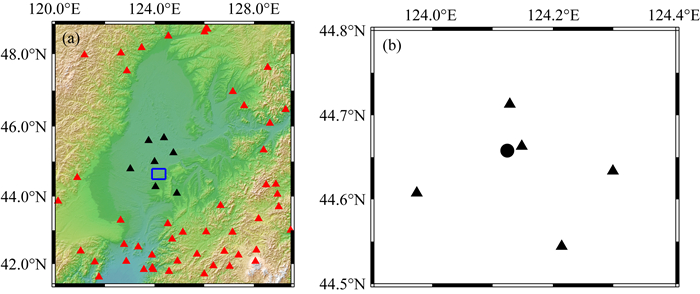
|
图 1 (a) Pg(黑色)与Pn(红色)震相台站分布图; (b) 震中距30 km之内的流动台站分布情况,三角为地震台站,黑色圆点为参考地震 Fig. 1 (a) Distribution of seismic stations for Pg (black), Pn (red); (b) Distributions of earthquakes and seismic stations. Black triangles are two permanent and potable seismic stations, black dots denote reference event |
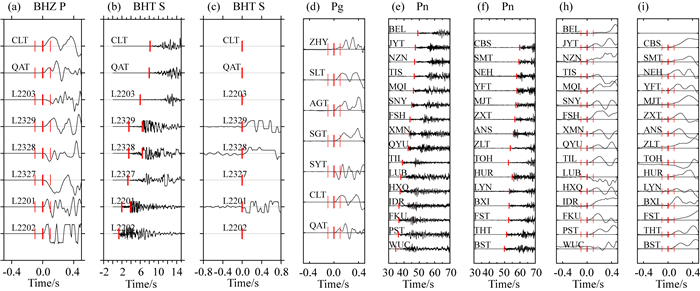
|
图 2 2013年11月22日MS5.2参考地震事件波形图,粗细红色竖线分别代表拾取的到时以及最大的误差范围 (a)垂向分量波形,(b)和(c)为切向分量波形,其中(c)为S震相放大图.(d)和(e,f)分别为M5.2参考事件固定台站Pg和Pn初动示意图;(h,i)为Pn震相局部放大. Fig. 2 Waveforms of reference event on 22 November, 2013, the thick and thin lines represent arrivaltimes of P waves and maximum errors, respectively (a) Vertical components. (b) and (c) Tangential components and short time windows of S phases. The onsets of Pg (d) and Pn (e, f) for MS5.2 reference event, (h, i) Zoom in view of Pn waves. |
|
|
表 1 地震定位所使用的速度模型 Table 1 Crustal velocity model for earthquake location |
|
|
表 2 MS5.2参考事件定位结果 Table 2 The hypocenter locations of MS5.2 reference earthquake |
基于参考地震,利用Pn/Pg方法对该地震序列中2个较大的地震进行重新测定.根据台站分布情况将震中距小于140 km的台站作为Pg,将震中距大于230 km台站作为Pn震相.选用MS5.2地震作为参考事件,其Pn震相清晰,过仔细挑选,拾取了7个Pg到时(图 2d)与31个台站Pn到时(图 2e和f),初至波拾取精度约在0.1 s左右(图 2h和i).同时,也拾取了该地震序列中MS5.6和MS5.8事件的P波到时.分析相对到时差随台站方位角特征(图 3a和b),发现相对时差呈现正弦分布特征,范围为-0.5~0.5 s.基于拾取的到时数据,设置深度步长为0.5 km,范围为1~10 km;水平位置步长为1 km,搜索范围为5 km.反演结果(图 4a和b)显示:两个地震起始深度均在3.5 km左右.

|
图 3 MS5.6(a)与MS5.8(b)地震Pn和Pg震相相对到时差随方位角分布 Fig. 3 Distribution of Pn and Pg relative difference traveltimes for the MS 5.6 (a) and MS5.8 (b) earthquake |
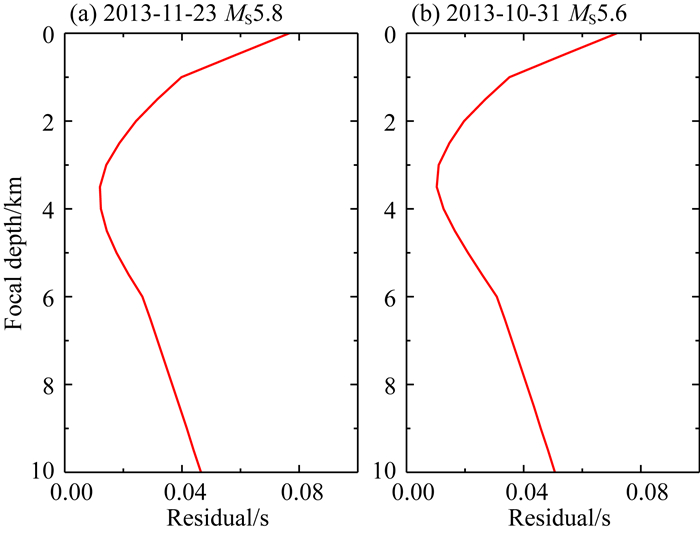
|
图 4 两个较大地震起始深度随残差分布,MS5.8 (a),MS5.6 (b) Fig. 4 Distribution of relative traveltime residuals with depth for two MS 5.5+ earthquakes |
|
|
表 3 2013年前郭MS5.8地震序中两个较大地震深度重新定位结果 Table 3 The hypocenter locations of two large earthquakes in 2013 Qianguo earthquake sequence |
为了确认地震震源深度的可靠性,本文同时利用gCAP方法对上述两个地震的质心深度进行测定.选择震中距300 km之内地震台站,其信噪比较高,将波形去仪器响应之后,旋转至大圆路径.Pnl和面波时窗长度分别设置为20 s和60 s,滤波范围是0.05~0.2 Hz和0.05~0.13 Hz.结果显示MS5.8地震的质心深度为5 km左右(图 5a),最佳深度波形拟合如图 5b所示,大部分台站波形拟合系数在0.7以上,可以看到Love波形复杂,持续时间较长,应为沉积层中的多次波,其也能较好拟合,说明使用的速度模型较为合适.利用相同的方法,我们还反演了MS5.6地震的震源参数,结果显示其质心深度在4 km左右,震源中包含有较大的非双力偶源分量(40%左右),这与刘俊清等(2017)研究成果一致.对于5级左右的地震来说,其破裂尺度在3 km左右,本文测得的地震起始和矩心深度差别在合理范围之内.

|
图 5 2013年11月23日前郭MS5.8主震VR随震源深度分布(a)以及最佳深度波形拟合情况(b) Fig. 5 Variance reduction residuals versus centroid depth (a) and waveform matching in the optimal centroid depth (b) of the MS5.8 mainshock on 23 November 2013 |
在2016年2月13日MW5.1地震发生之后,研究区域布设了多个流动台站,最小台间距约5 km,最近台站震中距约2 km,如图 6所示.选择两个4级左右地震事件,拾取P波与S波震相.然后基于3个不同地壳速度模型,利用HYP2000方法进行测定,结果如表 4和5所示.对于2016年6月8日MW4.2余震事件来说,不同模型给出的地震水平和深度定位误差均在0.5 km之内,但是对比不同模型的震源深度结果,发现Herrmann等(2011)以及OGS1D(Oklahoma地质调查局)模型反演的震源深度比较接近,相差0.5 km之内,但是和基于Keranen等(2013)模型相差约为1 km左右,平均深度为6.9 km,而2016年7月9日MW4.4余震定位结果也有类似之处,平均震源深度为7.5 km.为了减小深度定位误差,我们将三个深度的平均结果作为后续相对定位参考事件的深度.

|
图 6 地震事件以及台站分布情况 (a) Pg(黑色)与Pn(红色)震相台站分布图,黑色虚线和实线分别代表120 km与230 km震中距; (b) 震中距50 km范围内的台站分布情况,(c)图(b)中方框区域放大.红色、黑色和蓝色圆点分别为主震、MW4.4和MW4.2余震的震中位置,三角为地震 Fig. 6 Distributions of earthquakes and seismic stations (a) Pg (black), Pn (red). Black dashed and solid circle indicate the range within epicentral distance of 120 km and 230 km. (b) Distributions of seismic stations less than 50 km. (c) Zoom in view of box in (b). The mainshock (red), MW4.2 (blue) and MW4.4 reference event (black), Black triangles are two nearby permanent and potable seismic stations |
|
|
表 4 2016年7月8日MW4.2参考事件定位结果 Table 4 The hypocenter locations of MW4.2 earthquake on 8 July 2016 |
|
|
表 5 2016年7月9日MW4.4参考事件定位结果 Table 5 The hypocenter locations of MW4.4 earthquake on 9 July 2016 |
利用类似的数据处理方法,经过仔细挑选,对于MW4.2级参考事件,拾取了10个Pg到时(图 7a)与7个台站Pn到时(图 7b和c).Pg到时差(图 8a和b)范围为-0.2~0.2 s,250°方位角上,其差值为最大正值,到时差最小值大约在40°方位角上.不同方位角上Pn相对到时差幅度值整体小于Pg的,表明主震震源深度大于该参考事件.而对于MW4.4参考事件,不同方位角上Pn相对到时差幅度值整体略大于Pg(图 8c),表明主震震源深度小于该参考事件.两个参考事件相对到时差观测显示:主震震源深度位于两个参考事件深度之间.

|
图 7 MW5.1主震的Pg(a)和Pn(b)震相P波初动示意图,(c)为图(b)局部放大情形,粗细红色竖线分别代表拾取的到时以及最大的误差范围 Fig. 7 The onsets of Pg (a) and Pn (b) for MW5.1 mainshock, (c) zoom in view of (b), the thick and thin lines represent arrivaltimes of P waves and maximum errors, respectively |
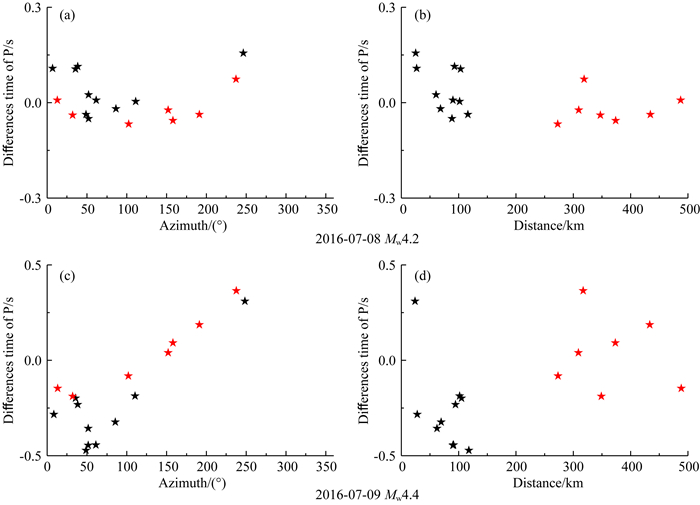
|
图 8 Pn和Pg相对到时差分布图 (a)为MW4.2参考事件Pg(黑色)和Pn(红色)相对到时差随方位角分布; (b)与(a)类似,但是随震中距分布.(c)和(d)为参考事件MW4.4到时差分布图. Fig. 8 Distribution of Pn and Pg relative difference traveltimes (a) Distribution of Pn (red) and Pg (black) relative difference traveltimes with azimuth for MW4.2 reference event; (b) The same as (a) but for epicentral distance; (c) and (d) are same as (a) and (b) but for MW4.4 reference event. |
选择类似的搜索步长,对MW5.1主震起始深度进行反演.结果显示(图 9a和b)起始深度分别为7 km和6.5 km,比MW4.2参考地震事件震源深度(6.9 km)略深,而比MW4.4参考事件震源深度(7.5 km)略浅,这符合理论预期.本研究结果与Schoenball和Ellsworth (2017)基于波形互相关相对定位结果(6.995 km)一致,也与Goebel等(2017)等研究结果(7 km)较为吻合.

|
图 9 MW5.1主震起始深度随残差分布,参考事件MW4.2 (a)和参考事件MW4.4 (b) Fig. 9 Distribution of relative traveltime residuals with depth for reference MW4.2 (a) and MW4.4 (b) |
针对MW5.1主震之前的5个4级地震,无近台记录,根据其到时测定的震源深度可能包含较大误差, 不同机构测得的震源深度相差较大(表 6).
|
|
表 6 2016年2月13 MW5.1地震序列几个较大前震以及余震重新定位结果 Table 6 The hypocenter locations of several large foreshocks and aftershocks of the MW5.1 sequence |
例如,2015年11月15日MW4.3地震事件,NEIC和Yeck等(2016)测得的结果相差6 km.其主要原因是在地震之前以及地震后早期时间,流动台站还没布设,固定近台较少,且方位角分布不理想,仅利用直达波到时测定的地震起始深度误差较大.本文使用同样方法对较大的前震进行了重新测定,结果如表 6.而对于流动台站架设完成之后的2个地震事件,NEIC,Yeck等(2016)以及本文测定的结果较为一致.为了考察本文测定结果的准确性,我们对比了几个4级左右的前震的质心深度(http://www.eas.slu.edu/eqc/eqc_mt/MECH.NA)与相对定位方法测定的结果,发现大部分地震两者相差在1.5 km左右,这符合4级左右地震的破裂大小.
3 讨论本文研究的两个案例具有一定的相似性,以2016年Fairview MW5.1地震为例,讨论Pn/Pg方法测定震源起始深度的不确定性,并分析对比讨论上述两个案例可能的成因.
Pn/Pg相对定位方法依赖于参考事件震源深度的准确性.为此,我们对两个余震相对位置进行确认.两个参考事件均被流动台站记录,Pg震相方位角覆盖良好,其相对到时差(MW4.4—MW4.2参考事件)在约50°方位角上为最大值,而在约230°方位角上最小(图 10).这说明两个参考事件在50°方位角上,这与多个近台绝对定位震中位置分布一致(图 10).Pn震相相对到时在不同方位角上小于Pg到时差,这显示MW4.2地震浅于MW4.4地震,两事件在深度分布上也与多台定位结果一致.为了方便对比,选择Herrmann等(2011)速度模型计算格林函数,利用波形方法反演了参考地震的震源深度,结果分别为6.0 km和6.5 km,这与Herrmann等人的反演结果一致(7 km).近台到时定位结果分别为6.9 km和7.5 km.四级左右地震破裂尺度大约1 km,质心深度与起始深度比较接近.

|
图 10 MW4.4和MW4.2参考事件Pn和Pg震相相对到时差随方位角分布情况 Fig. 10 Distribution of Pn (red) and Pg (black) relative difference traveltimes with azimuth for MW4.4 and MW4.2 reference event |
在上述震源深度测定过程中,将Pn和Pg的比例设置为相等权重.为了考察Pn以及Pg震相数据比例对震源深度测定的影响,本文使用bootstrapping方法对Pg以及Pn震相随机采样.基于从17个震相中随机挑选9个震相,使用Pn/Pg方法进行了500多次反演.对于MW4.2参考地震来说,反演结果大多数在6~7 km之间(图 11a).而对于MW4.4参考地震来说,反演结果大多数在5.5~6.5 km之间(图 11b).总的来说地震起始深度反演误差约为1 km.在密集台网地区,多个近台的直达波地震数据可以获取高精度的地震位置结果,而稀疏台网地区,缺少近台的震相到时,对地震起始深度约束较差,不同学者测得的2016年Fairview MW5.1地震起始深度相差约3 km.Pn/Pg相对到时方法基于定位准确的参考事件,并增加对深度敏感的Pn震相,有效地提高了该地震起始深度的测定精度.
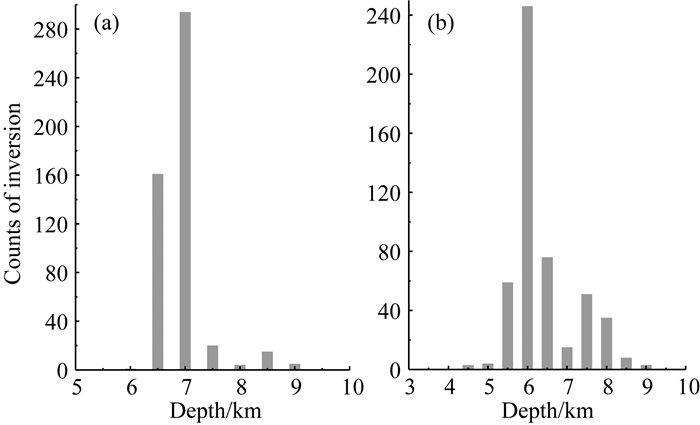
|
图 11 Pn以及Pg震相数据比例对震源深度测定结果的影响 (a) 以MW4.2地震作为参考事件; (b) 以MW4.4地震作为参考事件. Fig. 11 Uncertainties of hypocentral depth inversion for the mainshock based on MW4.2 (a) and MW4.4 (b) aftershock with different ratios of Pn and Pg phases |
基于参考地震事件,通过Pn/Pg相对到时定位方法,我们测定了MW5.1主震的较为准确的起始破裂深度,其结果为7 km左右.为了研究其地震破裂方式,基于gCAP方法,我们也反演了该地震的质心深度,结果为8 km左右.这表明,该地震可能是由浅部向深部破裂.为了更加深入了解该地震序列的发展过程,我们将本文得到的M4级左右地震震源深度与Schoenball和Ellsworth(2017)和Yeck等(2016)以及NEIC研究结果进行比较(图 12),发现不同机构测定的地震水平位置比较相近,而Yeck等(2016)几个地震较深,在9~12 km之间,经查看这些地震主要发生于地震早期,而在流动台布设之后,几个地震研究结果比较一致.从本文的结果来看,几个前震有由浅向深扩展的趋势.
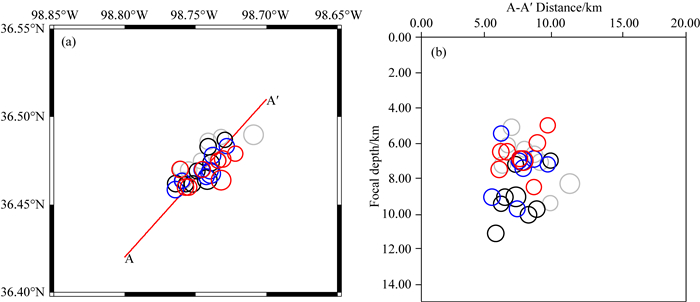
|
图 12 2016年2月13日Oklahoma地区MW5.1地震及其较大前震和余震分布 (a) 震中分布情况,灰色,黑色,蓝色和红色圆圈分别为NEIC, Yeck等(2016), Schoenball和Ellsworth(2017)以及本文重新定位后主震以及余震位置; (b) 不同定位结果在AA′剖面上的投影. Fig. 12 Distribution of the Fairview MW5.1 mainshock and early large aftershocks (a) Epicenters in the NEIC, Yeck et al. (2016), Schoenball and Ellsworth (2017) and our catalogs are shown as gray, black, blue and red circles. (b) Earthquakes projected on the profile AA′. |
为了进一步确定2016年Fairview MW5.1起始震源深度的准确性,我们利用远震深度(pP, sP)相进行研究.通常远震震相选取的震中距范围为30°~90°,在该震中距范围之内P波较为简单,不会包含受到地幔过渡带以及核幔边界的多次波.为了减小长周期噪声的影响,通常使用0.8~2 Hz的带通滤波.经过仔细挑选发现,震中距40°,方位角330°处的IM台阵波形信噪比比较高, 通过互相关台阵波形可以清楚地观测到深度震相(图 13).通过拟合理论地震波形可以看出地震的起始深度在6 km左右,与相对到时方法测定的结果较为一致.对于2013年11月22日前郭MS5.8地震来说,本文同样分析了其远震深度震,发现P波震相与后续的深度震相难以区分,波形拟合结果显示其震源深度在4 km左右.

|
图 13 利用远震深度震相测定2016年Fairview MW5.1主震震源深度,红色与黑色曲线分别为合成与观测地震波形 Fig. 13 Focal depth determination of the 2016 Fairview MW5.1 mainshock based on teleseismic depth phases, red and black lines denote synthetic and observed waveforms, respectively |
2013年11月前郭地震序列中两个较大地震起始和质心深度均较浅(3~5 km左右),其震区位于油田开发区,开采深度在3800 m左右.注水开采油气时,流体可以直接到达断层,从而导致孔隙应力增加,降低断层有效正应力,可导致沉积层浅部断层重新活动,同时震源中40%左右的非双力偶源成分也反映了震源的复杂性,推测应为开采时注入地下的流体产生的,这与刘俊清等(2017)根据震源特性研究结果一致.但是,本文尚未收集到油田区域注水井详细的注水资料,以及本文仅测定了地震序列中较大地震的起始深度,难以对注水活动与地震序列之间的因果关系进行更加仔细的分析.而2016年Fairview MW5.1地震序列几个前震以及主震的起始深度略浅与其质心深度,地震序列有由浅部向深部延伸的趋势.Goebel等(2017)注水应力扰动数值模拟显示该地震序列起始于浅部,并向深部发展.注水活动对断层的影响主要表现在两个方面,流体的直接影响,即孔隙流体扩散到断层时,增加断层的孔隙应力,处于临界状态和优选方位的断层最先滑移.另外一种是滞后响应,流体应力扰动传播至较远处断层附近时,可以诱发离注水井较远处的地震(Keranen et al., 2013).基于本文测定的震源深度结果,2013年前郭MS5.8地震序列可能是第一种诱发模式,而2016年Fairview MW5.1地震序列则应为第二种诱发模式.
4 结论针对沉积盆地中2013年11月MS5.8地震序列以及Oklahoma州Fairview地区2016 MW5.1地震序列,本文基于区域流动观测,获取了较大余震较可靠的震源位置,并将其作为参考事件,利用Pn/Pg方法测定了序列中较大地震起始破裂深度.结果显示:在2013年前郭地震序列中,主震起始破裂深度约3.5 km,而质心深度在5 km左右,结合震源机制中含有较大的非双力偶源成分,推断2013年11月前郭MS5.8地震序列可能与附近的注水活动有关.而2016年Fairview MW5.1地震起始深度约7 km,质心深度为8 km,5个较大的前震深度分布在5~9 km,该地震序列可能是由较远处注水活动引起的应力扰动所诱发的.
然而,上述两个地震案例都处于沉积盆地,浅层速度结构复杂,还需收集更多流动台站数据,获取震源区更加可靠的速度模型,并基于近台震相到时以及波形获取2~3级地震的震源深度和机制解,并结合注水活动资料,进一步研究地震丛集的成因.
致谢 感谢审稿人宝贵的修改意见和建议.国家测震台网数据备份中心(doi:10.11998/SeisDmc/SN)、吉林省地震局以及Incorporated Research Institutions for Seismology (https://www.iris.edu/hq/)为本研究提供地震波形数据,本文大部分图件由GMT绘制完成.
Chen X W, Nakata N, Pennington C, et al. 2017. The Pawnee earthquake as a result of the interplay among injection, faults and foreshocks. Scientific Reports, 7: 4945. DOI:10.1038/s41598-017-04992-z |
Chong J J, Ni S D, Zeng X F. 2010. sPL, an effective seismic phase for determining focal depth at near distance. Chinese Journal of Geophysics (in Chinese), 53(11): 2620-2630. DOI:10.3969/j.issn.0001-5733.2010.11.010 |
Dreger D, Kaverina A. 2000. Seismic remote sensing for the earthquake source process and near-source strong shaking: A case study of the October 16, 1999 Hector Mine earthquake. Geophysical Research Letters, 27(13): 1941-1944. DOI:10.1029/1999GL011245 |
Dreger D, Woods B. 2002. Regional distance seismic moment tensors of nuclear explosions. Tectonophysics, 356(1-3): 139-156. DOI:10.1016/S0040-1951(02)00381-5 |
Fang L H, Wu J P, Wang W L, et al. 2015. Aftershock observation and analysis of the 2013 MS7.0 Lushan earthquake. Seismological Research Letters, 86(4): 1135-1142. DOI:10.1785/0220140186 |
Goebel T H W, Weingarten M, Chen X, et al. 2017. The 2016 MW5.1 Fairview, Oklahoma earthquakes: Evidence for long-range poroelastic triggering at >40 km from fluid disposal wells. Earth and Planetary Science Letters, 472: 50-61. DOI:10.1016/j.epsl.2017.05.011 |
Guo H, Zhang H J. 2017. Development of double-pair double difference earthquake location algorithm for improving earthquake locations. Geophysical Journal International, 208(1): 333-348. DOI:10.1093/gji/ggw397 |
He X H, Li T, Wu C Y, et al. 2020. Resolving the rupture directivity and seismogenic structure of the 2017 Jinghe MS6.6 earthquake with regional seismic waveforms. Chinese Journal of Geophysics (in Chinese), 63(4): 1459-1471. DOI:10.6038/cjg2020N0309 |
Herrmann R B, Benz H, Ammon C J. 2011. Monitoring the earthquake source process in North America. Bulletin of the Seismological Society of America, 101(6): 2609-2625. DOI:10.1785/0120110095 |
Herrmann R B. 2013. Computer programs in seismology: An evolving tool for instruction and research. Seismological Research Letters, 84(6): 1081-1088. DOI:10.1785/0220110096 |
Jia Z, Ni S D, Chu R S, et al. 2016. Joint inversion for earthquake depths using local waveforms and amplitude spectra of rayleigh waves. Pure and Applied Geophysics, 174(1): 261-277. DOI:10.1007/s00024-016-1373-1 |
Keranen K M, Savage H M, Abers G A, et al. 2013. Potentially induced earthquakes in Oklahoma, USA: Links between wastewater injection and the 2011 MW5.7 earthquake sequence. Geology, 41(6): 699-702. DOI:10.1130/G34045.1 |
Lei X L, Wang Z W, Su J R. 2019. The December 2018 ML5.7 and January 2019 ML5.3 earthquakes in south Sichuan basin induced by shale gas hydraulic fracturing. Seismological Research Letters, 90(3): 1099-1110. DOI:10.1785/0220190029 |
Li S Q, Chen Q F, Zhao L, et al. 2013. Anomalous focal mechanism of the May 2011 MW5.7 deep earthquake in Northeastern China: regional waveform inversion and possible mechanism. Chinese Journal of Geophysics (in Chinese), 56(9): 2959-2970. DOI:10.6038/cjg20130910 |
Li Z W, Huang Z B, Wang X X, et al. 2015. A study on the reliability of M4~5 earthquakes with anomalous focal depth in the USGS earthquake catalog: several earthquakes in the North-South Seismic Belt. Chinese Journal of Geophysics (in Chinese), 58(4): 1236-1250. DOI:10.6038/cjg20150412 |
Liang S S, Lei J S, Xu Z G, et al. 2018. Relocation of aftershocks of the 2017 Jiuzhaigou, Sichuan, MS7.0 earthquake and inversion for focal mechanism of the mainshock. Chinese Journal of Geophysics (in Chinese), 61(5): 2163-2175. DOI:10.6038/cjg2018L0508 |
Liu J Q, Liu C, Lei J S, et al. 2017. The moment tensors of the 2013 Qianguo MS5.8 seismic swarm. Chinese Journal of Geophysics (in Chinese), 60(9): 3418-3431. DOI:10.6038/cjg20170912 |
Liu S Q, Xue Y, Cai H L, et al. 2015. Discussion on cause factor of Jilin Qianguo MS5.8 earthquake sequence in 2013 using focal depth characteristic of relocation. Journal of Seismological Research (in Chinese), 38(2): 211-220. |
Ross Z E, Ben-Zion Y, Zhu L. 2015. Isotropic source terms of San Jacinto fault zone earthquakes based on waveform inversions with a generalized CAP method. Geophysical Journal International, 200(2): 1269-1280. DOI:10.1093/gji/ggu460 |
Schoenball M, Ellsworth W L. 2017. Waveform-relocated earthquake catalog for oklahoma and southern kansas illuminates the regional fault network. Seismological Research Letters, 88(5): 1252-1258. DOI:10.1785/0220170083 |
Spence W. 1980. Relative epicenter determination using P-wave arrival-time differences. Bulletin of the Seismological Society of America, 70(1): 171-183. |
Su J R, Zheng Y, Yang J S, et al. 2013. Accurate locating of the Lushan, Sichuan M7.0 earthquake on 20 April 2013 and its aftershocks and analysis of the seismogenic structure. Chinese Journal of Geophysics (in Chinese), 56(8): 2636-2644. DOI:10.6038/cjg20130813 |
Tian X, Zhang W, Zhang X, et al. 2020. Comparison of single-trace and multiple-trace polarity determination for surface microseismic data using deep learning. Seismological Research Letters, 91(3): 1974-1803. |
Tian Y, Chen X F. 2002. Review of seismic location study. Progress in Geophysics (in Chinese), 17(1): 147-155. |
Tsai Y B, Aki K. 1970. Precise focal depth determination from amplitude spectra of surface waves. Journal of Geophysical Research, 75(29): 5729-5744. DOI:10.1029/JB075i029p05729 |
Wagner M, Husen S, Lomax A, et al. 2013. High-precision earthquake locations in Switzerland using regional secondary arrivals in a 3-D velocity model. Geophysical Journal International, 193(3): 1589-1607. DOI:10.1093/gji/ggt052 |
Waldhauser F, Ellsworth W L. 2000. A double-difference earthquake location algorithm: Method and application to the northern Hayward fault, California. Bulletin of the Seismological Society of America, 90(6): 1353-1368. DOI:10.1785/0120000006 |
Wang R T, Li Z W, Bao F, et al. 2019. S-wave velocity structure of sediment in Songliao Basin from short-period ambient noise tomography. Chinese Journal of Geophysics (in Chinese), 62(9): 3385-3399. DOI:10.6038/cjg2019M0144 |
Wang X T, Ni S D, Zhou Y, et al. 2019. Topography effects for focal depth inversion of shallow earthquakes based on waveforms: A case study for the M6.3 event on 3 September 2017 in Democratic People's Republic of Korea. Chinese Journal of Geophysics (in Chinese), 62(12): 4684-4695. DOI:10.6038/cjg2019M0474 |
Wang X T, Wang S F, Li Z W, et al. 2019. Source Characterization of Some Collapse Earthquakes due to Mining Activities in Shandong and Beijing, North China. Seismological Research Letters, 90(1): 183-193. DOI:10.1785/0220180184 |
Wei X, Wang X T, Li Z W, et al. 2019. Initial rupture depth of the 8 August 2017 M7.0 Jiuzhaigou earthquake derived from Pn/Pg relative location. Chinese Journal of Geophysics (in Chinese), 62(4): 1300-1311. DOI:10.6038/cjg2019L0796 |
Wu W W, Yang J S, Su J R, et al. 2014. Moment inversion of moderate earthquakes and seismogenic environment in Qianguo-Qian'an source region, 2013, Jilin Province. Chinese Journal of Geophysics (in Chinese), 57(8): 2541-2554. DOI:10.6038/cjg20140815 |
Xie Z J, Jin B K, Zheng Y, et al. 2013. Source parameters inversion of the 2013 Lushan earthquake by combining teleseismic waveforms and local seismograms. Science China Earth Sciences, 56(7): 1177-1186. DOI:10.1007/s11430-013-4640-3 |
Xie Z J, Zheng Y, Yao H J, et al. 2018. Preliminary analysis on the source properties and seismogenic structure of the 2017 MS7.0 Jiuzhaigou earthquake. Science China Earth Sciences, 61(3): 339-352. DOI:10.1007/s11430-017-9161-y |
Yang Y, Lei J S, Zhang G W, et al. 2019. Crustal velocity structure and seismogenic environment in the source areas of the Qianguo MS5.8 and Songyuan MS5.7 earthquakes. Chinese Journal of Geophysics (in Chinese), 62(11): 4259-4278. DOI:10.6038/cjg2019M0652 |
Yeck W L, Weingarten M, Benz H M, et al. 2016. Far-field pressurization likely caused one of the largest injection induced earthquakes by reactivating a large preexisting basement fault structure. Geophysical Research Letters, 43(19): 10198-10207. DOI:10.1002/2016GL070861 |
Yi G X, Long F, Liang M J, et al. 2017. Focal mechanism solutions and seismogenic structure of the 8 August 2017 M7.0 Jiuzhaigou earthquake and its aftershocks, northern Sichuan. Chinese Journal of Geophysics (in Chinese), 60(10): 4083-4097. DOI:10.6038/cjg20171033 |
Yi G X, Long F, Liang M J, et al. 2019. Focal mechanism solutions and seismogenic structure of the 17 June 2019 MS6.0 Sichuan Changning earthquake sequence. Chinese Journal of Geophysics (in Chinese), 62(9): 3432-3447. DOI:10.6038/cjg2019N0297 |
Zhang G W, Lei J S. 2015. Mechanism of the 2011 Tengchong, Yunnan, MS5.2 double earthquakes. Chinese Journal of Geophysics (in Chinese), 58(4): 1194-1204. DOI:10.6038/cjg20150409 |
Zhang G W, Lei J S, Sun D Y. 2019. The 2013 and 2017 MS5 seismic swarms in Jilin, NEChina: fluid-triggered earthquakes?. Journal of Geophysical Research: Solid Earth, 124(12): 13096-12111. DOI:10.1029/2019JB018649 |
Zhang H, Chen X H, Zhang L Y. 2017. 3D simultaneous seismic data reconstruction and noise suppression based on the curvelet transform. Applied Geophysics, 14(1): 87-95. DOI:10.1007/s11770-017-0607-z |
Zhao B, Gao Y, Liu J, et al. 2019. Focal mechanism inversion and source depth locating of moderate-major earthquakes in the Sichuan region since 2010. Chinese Journal of Geophysics (in Chinese), 62(1): 130-142. DOI:10.6038/cjg2019M0155 |
Zhao L S, Helmberger D V. 1994. Source estimation from broadband regional seismograms. Bulletin of the Seismological Society of America, 84(1): 91-104. |
Zheng Y, Ni S D, Xie Z J, et al. 2010. Strong aftershocks in the northern segment of the Wenchuan earthquake rupture zone and their seismotectonic implications. Earth, Planets and Space, 62(11): 881-886. DOI:10.5047/eps.2009.06.001 |
Zhou S Y, Xu Z H, Chen X F. 2001. Analysis on the source characteristics of the 1997 Jiashi swarm, western China. Chinese Journal of Geophysics (in Chinese), 44(5): 654-662. |
Zhu L P, Helmberger D V. 1996. Advancement in source estimation techniques using broadband regional seismograms. Bulletin of the Seismological Society of America, 86(5): 1634-1641. |
Zhu L P, Ben-Zion Y. 2013. Parametrization of general seismic potency and moment tensors for source inversion of seismic waveform data. Geophysical Journal International, 194(2): 839-843. DOI:10.1093/gji/ggt137 |
Zhu Y Q, Shi Y L, Li P. 1990. A new method for determining focal depth of earthquakes. Seismological and Geomagnetic Observation and Research, 11(2): 4-12. |
崇加军, 倪四道, 曾祥方. 2010. sPL, 一个近距离确定震源深度的震相. 地球物理学报, 53(11): 2620-2630. DOI:10.3969/j.issn.0001-5733.2010.11.010 |
何骁慧, 李涛, 吴传勇, 等. 2020. 基于区域地震波形的2017年新疆精河MS6.6地震破裂方向性及发震构造研究. 地球物理学报, 63(4): 1459-1471. DOI:10.6038/cjg2020N0309 |
李圣强, 陈棋福, 赵里, 等. 2013. 2011年5月中国东北MW5.7深震的非同寻常震源机制: 区域波形反演与成因探讨. 地球物理学报, 56(9): 2959-2970. DOI:10.6038/cjg20130910 |
李志伟, 黄志斌, 王晓欣, 等. 2015. USGS地震目录中4~5级震源深度异常地震可靠性初步研究: 以南北地震带若干地震为例. 地球物理学报, 58(4): 1236-1250. DOI:10.6038/cjg20150412 |
梁姗姗, 雷建设, 徐志国, 等. 2018. 2017年四川九寨沟MS7.0强震的余震重定位及主震震源机制反演. 地球物理学报, 61(5): 2163-2175. DOI:10.6038/cjg2018L0508 |
刘俊清, 刘财, 雷建设, 等. 2017. 2013年前郭MS5.8震群矩张量研究. 地球物理学报, 60(9): 3418-3431. DOI:10.6038/cjg20170912 |
刘双庆, 薛艳, 蔡宏雷, 等. 2015. 利用重测定的震源深度特征探讨2013年吉林前郭5.8级震群发震因素. 地震研究, 38(2): 211-220. |
苏金蓉, 郑钰, 杨建思, 等. 2013. 2013年4月20日四川芦山M7.0级地震与余震精确定位及发震构造初探. 地球物理学报, 56(8): 2636-2644. DOI:10.6038/cjg20130813 |
田玥, 陈晓非. 2002. 地震定位研究综述. 地球物理学进展, 17(1): 147-147. DOI:10.3969/j.issn.1004-2903.2002.01.022 |
王仁涛, 李志伟, 包丰, 等. 2019. 松辽盆地沉积层结构的短周期地震背景噪声成像研究. 地球物理学报, 62(9): 3385-3399. DOI:10.6038/cjg2019M0144 |
王向腾, 倪四道, 周勇, 等. 2019. 地形起伏对基于地震波形的浅源地震深度反演影响-以2017年9月3日朝鲜M6.3事件为例. 地球物理学报, 62(12): 4684-4695. DOI:10.6038/cjg2019M0474 |
魏星, 王向腾, 李志伟, 等. 2019. 基于Pn/Pg相对定位方法研究2017年8月8日九寨沟M7.0地震起始破裂深度.. 地球物理学报, 62(4): 1300-1311. DOI:10.6038/cjg2019L0796 |
吴微微, 杨建思, 苏金蓉, 等. 2014. 2013年吉林前郭-乾安震源区中强地震矩张量反演与区域孕震环境研究. 地球物理学报, 57(8): 2541-2554. DOI:10.6038/cjg20140815 |
杨宇, 雷建设, 张广伟, 等. 2019. 前郭MS5.8和松原MS5.7地震震源区地壳速度结构与孕震环境. 地球物理学报, 62(11): 4259-4278. DOI:10.6038/cjg2019M0652 |
杨智娴, 陈运泰, 郑月军, 等. 2003. 双差地震定位法在我国中西部地区地震精确定位中的应用. 中国科学(D辑), 33(Z1): 129-134. |
易桂喜, 龙锋, 梁明剑, 等. 2017. 2017年8月8日九寨沟M7.0地震及余震震源机制解与发震构造分析. 地球物理学报, 60(10): 4083-4097. DOI:10.6038/cjg20171033 |
易桂喜, 龙锋, 梁明剑, 等. 2019. 2019年6月17日四川长宁MS6.0地震序列震源机制解与发震构造分析. 地球物理学报, 62(9): 3432-3447. DOI:10.6038/cjg2019N0297 |
张广伟, 雷建设. 2015. 2011年云南腾冲5.2级双震发震机理. 地球物理学报, 58(4): 1194-1204. DOI:10.6038/cjg20150409 |
赵博, 高原, 刘杰, 等. 2019. 2010年以来四川地区中强地震震源机制反演及深度确定. 地球物理学报, 62(1): 130-142. DOI:10.6038/cjg2019M0155 |
周仕勇, 许忠淮, 陈晓非. 2001. 伽师强震群震源特征及震源机制力学成因分析. 地球物理学报, 44(5): 654-662. DOI:10.3321/j.issn:0001-5733.2001.05.009 |
朱元清, 石耀霖, 李平. 1990. 一种确定地震深度的新方法. 地震地磁观测与研究, 11(2): 4-12. |
 2021, Vol. 64
2021, Vol. 64


